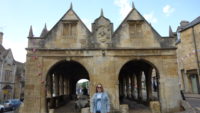 One of the real joys in travel is experiencing serendipity, the unexpected, when the encounter is unplanned and a happy one. I had no real plans today other than to explore some cute Cotswolds towns. Add in one closed door and one open one, and things got interesting.
One of the real joys in travel is experiencing serendipity, the unexpected, when the encounter is unplanned and a happy one. I had no real plans today other than to explore some cute Cotswolds towns. Add in one closed door and one open one, and things got interesting.
We got a bit of a late start because of our late night last night, so we didn’t get to our first town of the day, Chipping Campden, until a little before noon. After driving several one-lane roads, navigating the park-where-you-want-to busy and crowded High Street was stressful, but we found the local school parking lot, which allows public parking on the weekends.
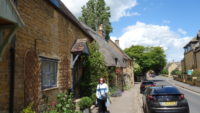 Chipping Campden is known for its High Street, which is long and made up of uniformly designed row buildings, constructed between the 1300s to the 1600s. The buildings are all made of a local yellow stone that is so associated with the area that all new construction in the Cotswolds must use it to maintain the harmonious look. Campden made its money in the wool trade, and when that market collapsed, the town (along with much of the Cotswolds) sort of hit the pause button while the rest of the world went along. That is why the area is packed with tourists now – the old villages are cute and quaint.
Chipping Campden is known for its High Street, which is long and made up of uniformly designed row buildings, constructed between the 1300s to the 1600s. The buildings are all made of a local yellow stone that is so associated with the area that all new construction in the Cotswolds must use it to maintain the harmonious look. Campden made its money in the wool trade, and when that market collapsed, the town (along with much of the Cotswolds) sort of hit the pause button while the rest of the world went along. That is why the area is packed with tourists now – the old villages are cute and quaint.
We did a Rick Steves recommended walk down High Street, where we noticed lots of fancy-dressed people around. We had seen signs for a wedding, so we assumed they were guests. We later found out there were two weddings in the local church that day, so it seems the Cotswolds make for a good wedding destination.
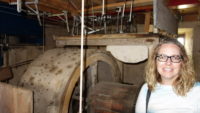 My one disappointment on the walk was that the silversmith’s shop was closed. I like silver, and I like skilled tradespeople, so I had wanted to see the shop; it closed at noon, and we got there about 12:30. We did go into a shop that was run by the son and daughter of a famous designer in metal housewares. It was beautiful stuff, but very expensive (a salt and pepper mill ran over a hundred dollars). Money can’t buy happiness, but it sure can buy elegance and class.
My one disappointment on the walk was that the silversmith’s shop was closed. I like silver, and I like skilled tradespeople, so I had wanted to see the shop; it closed at noon, and we got there about 12:30. We did go into a shop that was run by the son and daughter of a famous designer in metal housewares. It was beautiful stuff, but very expensive (a salt and pepper mill ran over a hundred dollars). Money can’t buy happiness, but it sure can buy elegance and class.
The walk ended at the village church, where the wedding was. We thought it was over because we had seen guests in town, and there was no indication it was still going on. When I slowly tried to open the main door (the one with a sign that said, “Turn handle and push”), I got a frowning woman appearing in the crack in the door, indicating that the church was in use. That was fine as it went, but a sign would have worked well to prevent our attempted intrusion from happening.
 On the way out, we swung by the side of the church to look at a headstone for the church cat who had passed away in 1986, when I saw an open door with a spiral staircase beyond. Of course I had to go look. We went up very quietly in case sound would transmit into the church, and we came to an open door and a platform where four retirement-aged people were sitting around talking. I asked if we could come in, and they said yes.
On the way out, we swung by the side of the church to look at a headstone for the church cat who had passed away in 1986, when I saw an open door with a spiral staircase beyond. Of course I had to go look. We went up very quietly in case sound would transmit into the church, and we came to an open door and a platform where four retirement-aged people were sitting around talking. I asked if we could come in, and they said yes.
Thus began a delightful and happy hour or so. The people there were bell ringers. The church has eight bells, and they were there to ring them in specific patterns before and after the wedding. They had eight people to ring the bells, but since the wedding was going to take about an hour, four members had popped down to the pub for a drink. We chatted about bells and why the British are deeply honoring of WW I monuments (the theory put forward by one man was because towns sent their young men to fight in the same units, so many towns lost many of their young men all at once). We talked about real estate prices (very high in England – we rarely have seen stand-alone houses for under $500,000), and how young people don’t seem to be interested in learning about bell ringing.
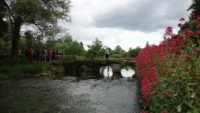 Bell ringing is an art, it seems. You need to pull on the rope with the right force and with the right rhythm to get the bell swinging; the bells start upside down and rotate to a standard position (ringing once), then reverse in the other direction (ringing again). We learned that for funerals, one side of the clapper is muted, which means you get a muted ring every other ring. When a monarch dies, both sides of the clapper are muted. At least in theory – it hasn’t been done in seventy years. Oh, and when the bells are going full blast, we could feel the tower moving slightly; we had been warned that would happen and were told it was okay.
Bell ringing is an art, it seems. You need to pull on the rope with the right force and with the right rhythm to get the bell swinging; the bells start upside down and rotate to a standard position (ringing once), then reverse in the other direction (ringing again). We learned that for funerals, one side of the clapper is muted, which means you get a muted ring every other ring. When a monarch dies, both sides of the clapper are muted. At least in theory – it hasn’t been done in seventy years. Oh, and when the bells are going full blast, we could feel the tower moving slightly; we had been warned that would happen and were told it was okay.
We were joined at some point by the other four ringers (one of whom turned out to be the eighty-four-year-old silversmith we had missed at the shop), and they let us stay to watch them ring after the wedding. One woman called out the various changes in the ringing patterns, and the others followed along. They rang two sets, each lasting four or five minutes. They then took a break since they had another wedding coming up in an hour. Meanwhile, one of the ringers offered to take us up to see the bells, to which we eagerly agreed.
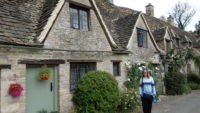 We were shown the carillon that was built in 1789 and still works. It is designed to strike the bells when they are in the down position, so when the bells are up to be rung by ringers, the carillon can’t strike anything. The ringers leave the bells up if there are weddings coming up since it takes a lot of work to build up to slowly getting the bell into the upside-down position. We then got to stick our heads up a ladder to see the bells themselves, and then went up another level to see the old wooden bell frame. It was deemed unsafe for the bells in 1990, and a steel frame was constructed below. Because the wooden frame is so old, the law stated it had to be left untouched. The same went for one of the bells that cracked – it sits unused in the tower because it can’t be melted down and recast.
We were shown the carillon that was built in 1789 and still works. It is designed to strike the bells when they are in the down position, so when the bells are up to be rung by ringers, the carillon can’t strike anything. The ringers leave the bells up if there are weddings coming up since it takes a lot of work to build up to slowly getting the bell into the upside-down position. We then got to stick our heads up a ladder to see the bells themselves, and then went up another level to see the old wooden bell frame. It was deemed unsafe for the bells in 1990, and a steel frame was constructed below. Because the wooden frame is so old, the law stated it had to be left untouched. The same went for one of the bells that cracked – it sits unused in the tower because it can’t be melted down and recast.
We were deeply touched at the kindness of these people who took so much time to talk to us about what they do. It’s one of the reasons I love nerds of all kinds – anyone who is passionate about something usually is pretty interesting. We thanked them profusely and went back into town for a late lunch.
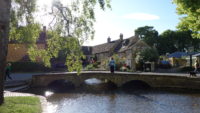 After lunch, we drove forty minutes to the southern part of the Cotswolds, to the tiny village of Bibury. Everything I had read said it was cute, and it was. Nothing I had read mentioned it is four streets that can be seen in about fifteen minutes. But we did catch the church open, and happened to see the bell ringers at work in there, since these bell ropes came all the way to the ground floor.
After lunch, we drove forty minutes to the southern part of the Cotswolds, to the tiny village of Bibury. Everything I had read said it was cute, and it was. Nothing I had read mentioned it is four streets that can be seen in about fifteen minutes. But we did catch the church open, and happened to see the bell ringers at work in there, since these bell ropes came all the way to the ground floor.
Since I knew we would want supper, I decided we should eat it in a cute place that was a sure thing. So I drove back to Bouton-on-the-Water through a quick rain shower. By the time we got to the town thirty minutes later, the sun had come out. The town was fairly quiet at 5:00 in the evening, and even more so by 6:00 as we came out from supper. We strolled around, enjoying the evening sun hitting the water – we both think evening light is magical, and it is a pretty magical place to be on top of that. We finally headed back to the inn around 7:30.
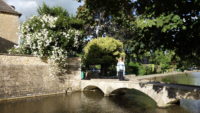 Tomorrow we are off to Canterbury. Things may go according to plan, and I hope they do. But I will always try to be flexible to let blessings strike whenever they want to. What a good day.
Tomorrow we are off to Canterbury. Things may go according to plan, and I hope they do. But I will always try to be flexible to let blessings strike whenever they want to. What a good day.
Nerd passion is why Jo and I make it a policy to always find the docents. Always good for outstanding information or, in Jo’s case, having the (female) docent get carried away with excitement and pat Jo absentmindedly on the boob.
Oh, in Chipping Campden did you see the WW2 bit about the town removing all its signs in case the Germans invaded? Neat town.
I didn’t see that. Neat.